It can be alarming when your pothos has yellow leaves. We don’t want to see our houseplants unhappy and yellow leaves on pothos plants may indicate that something is wrong.
While there are a few reasons why pothos leaves may turn yellow, with a little investigation, you should be able to figure out the cause and correct it fairly easily.
Read on to learn about the most common reasons for why your pothos’ leaves are turning yellow and how to nip them in the bud.

Table of Contents
Why are my pothos leaves turning yellow?
1. Not enough fertilizer
Fertilizer is necessary for pothos plants to thrive. If you notice that your pothos leaves are turning yellow, it may be a sign that your plant is not getting enough fertilizer.
There are many different nutrients that your plant may be lacking, including nitrogen, phosphorus, and potassium. A good fertilizer for your pothos will have a high percentage of these nutrients.
2. Overexposure to sunlight
Pothos plants prefer bright indirect light that is similar to the light found near a window.
However, if your pothos plant is getting too much direct sunlight, the leaves may start to turn yellow due to sunburn, and eventually brown. This can eventually kill the plant as well as severely dry it out.
3. Extreme temperatures
The proper temperature range for a pothos plant is 60-85 degrees Fahrenheit. If the temperature gets too hot or too cold, it can cause the leaves to turn yellow.
If you have a pothos with yellow leaves, check the temperature of the room your pothos is in and make sure it falls within the ideal range. Make sure you also remove the plant from drafty areas such as windows or doors.

4. Not enough water
Yellow leaves on pothos may be a result of a very thirsty plant. When your pothos plant doesn’t get enough water, it will wilt and lose its coloration. This is because the leaves are not getting the hydration they need to stay healthy and green.
5. Too much water leading to root rot
On the other hand, too much water may be the culprit when you see your pothos leaves turning yellow. This is a common problem for pothos plants that are kept in pots without drainage holes.
When the roots of your plant sit in water for too long, they will start to rot, which will cause the leaves to turn yellow and eventually brown.
6. The pothos is rootbound
When a pothos is rootbound, it means that the roots have outgrown the pot it’s in and are starting to circle the inside of the pot. This can cause several problems for your plant, including yellow leaves.
You can tell if your plant is rootbound by looking at the roots through the drainage holes in the bottom of the pot and looking for a mass of white roots growing or breaking out of the container.
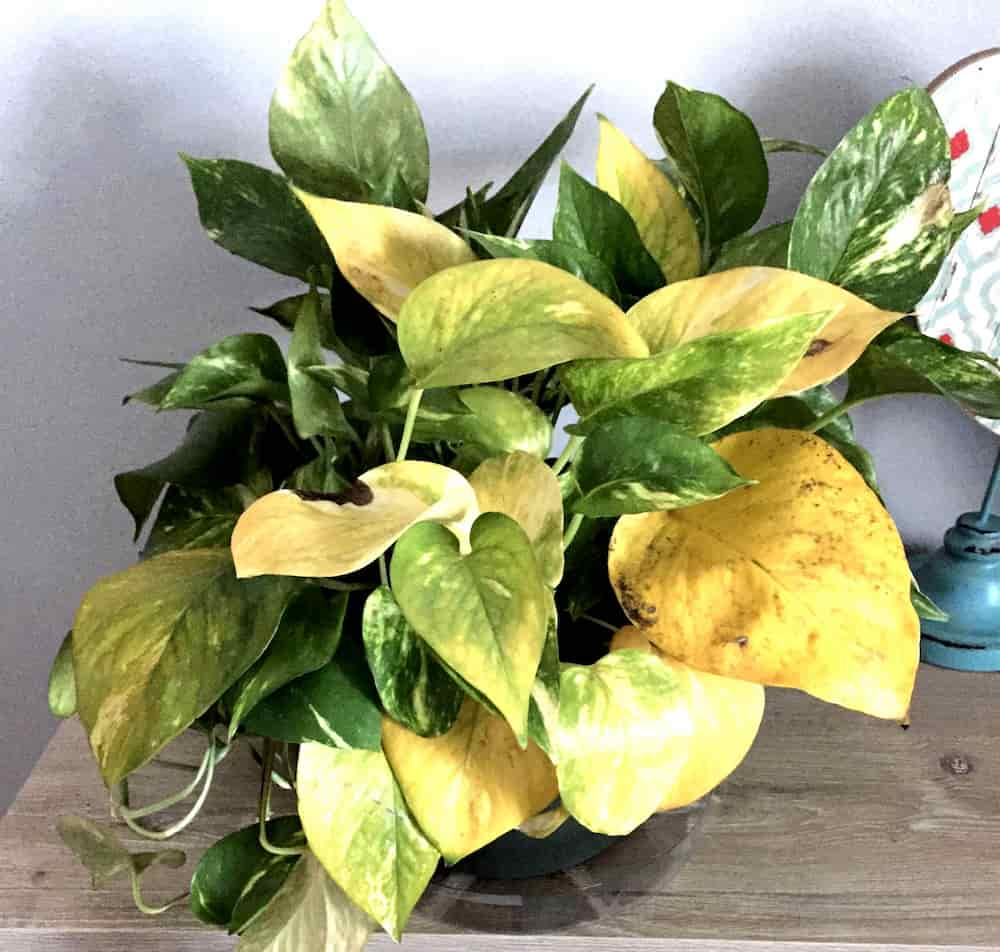
7. Bacterial or fungal infections
There are many bacterial and fungal infections that can lead to pothos leaves turning yellow, including root rot, powdery mildew, and leaf spot.
These infections are often the result of too much moisture or humidity and can be difficult to treat if not identified immediately. One of the first signs is usually drooping yellow leaves.
8. Poor soil drainage and quality
Soil quality is an important factor in the health of your pothos plant. If the pothos’ soil does not drain well, it can cause the roots to sit in water for too long and eventually rot.
Additionally, there may be a lack of nutrients in the soil that is causing the leaves to turn yellow.
9. The leaves are aging
As pothos leaves age, they will start to yellow and eventually brown. This is a natural process and is not indicative of a problem with your plant.
You can remove the older leaves as they turn yellow to encourage new growth.

How do I fix yellow leaves on my pothos?
1. Add fertilizer to your soil
If you’ve noticed yellow leaves on your pothos and think that the culprit may be that the plant is not getting enough fertilizer, you can add it to the soil. Look for a balanced fertilizer that has a ratio of nitrogen, phosphorus, and potassium, such as 20-20-20.
Follow the package instructions on how often to fertilize your pothos to make sure you don’t overfertilize them, which can also damage the plant’s leaves.
2. Adjust your plant’s sunlight intake
In order to avoid direct sunlight, make sure to move your plant a foot or two away from the window, which will help reduce the intensity of the sun. You can also take a translucent curtain and place it over the window to diffuse the light.
Keep an eye on your plant to see if this helps, and if it doesn’t, consider moving it even further away from the light source.
3. Control the temperature in the area
Try to regulate the temperature in the room where your pothos plant is located. If it’s too cold, move the plant to a warmer area of the house and if it’s too hot, find a cooler location.
Choose a room that isn’t disturbed much so that there aren’t fluctuations in temperature. After all, it’s not only extremes in temperature which can cause yellow leaves on a pothos, but also sudden changes, like from drafts in your home.
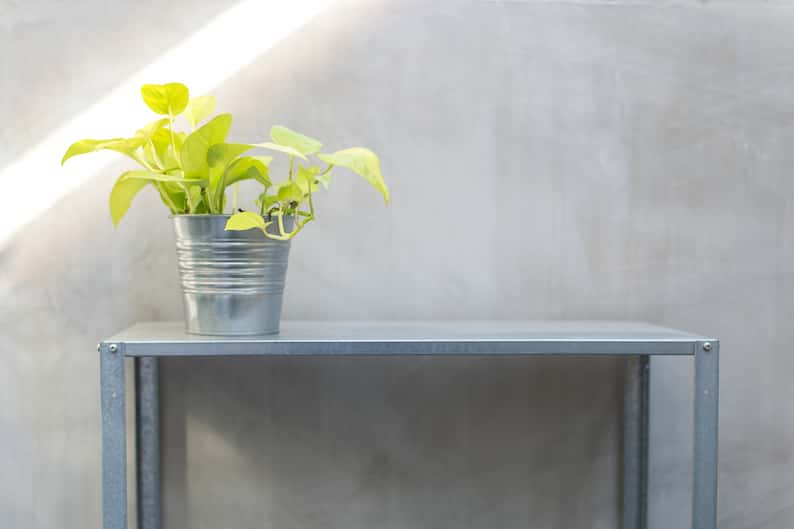
4. Control the humidity in the area
Humidity may also be a factor in the yellowing of your pothos leaves. If the air is too dry, the leaves will start to turn brown and if it’s too humid, the leaves will turn yellow.
Try to keep your pothos’ humidity around 50% and if you need to, use a humidifier or place a bowl of water near your plant.
5. Make sure to water your pothos correctly
These plants can be sensitive to overwatering, with yellow leaves on your pothos being one sign of this, so it’s important to make sure you’re not giving your plant too much water. When you do water your plant, make sure to let the soil dry out completely before watering it again.
A good way to test the soil is to stick your finger in it up to the first knuckle. If it feels moist, wait a few days before watering again.
6. Replant your pothos plant
If your pothos plant has become rootbound, you will need to repot it into a larger container. Choose a pot that is about two inches larger in diameter than the current one and has drainage holes in the bottom.
Gently remove your plant from the old pot and loosen up the roots before placing it in the new pot, following with a watering afterward.
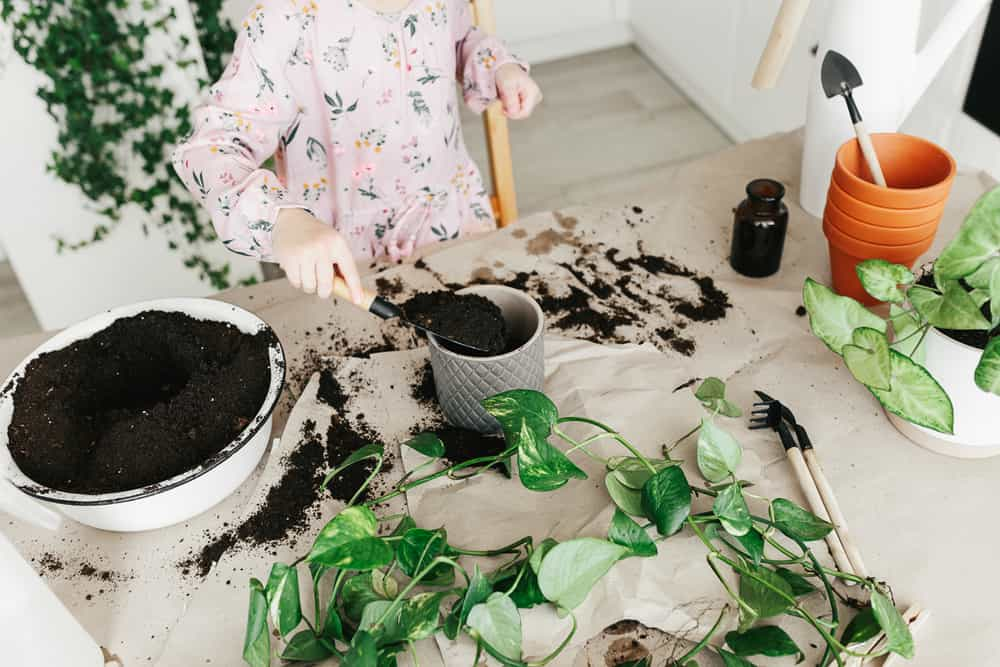
7. Check for and treat any infections
It can be hard to identify infections in plants, but there are a few signs to look out for. If you see your pothos has yellow leaves that also have black or brown spots on them, these could be leaf spot.
If the leaves are covered in a white powder, this is powdery mildew, and if the leaves are drooping and yellow, this could be root rot.
8. Use Neem to treat infections
Neem is a powerful and natural way to treat fungal infections and pests. Mix together neem oil and water at a ratio of about two teaspoons of neem oil per cup of water. Use a spray bottle to apply the mixture to your plant, making sure to coat the leaves completely.
Apply this treatment every seven to ten days until the infection is gone.
9. Aerate or replace the potting soil
Drainage is important for pothos plants, so make sure your potting soil is aerated and not waterlogged. If the soil is too dense, it won’t allow the roots to breathe and will eventually lead to root rot, one of the first signs of which is your pothos’ leaves turning yellow.
You can add perlite or vermiculite to the soil to improve drainage or you can replace the soil entirely.
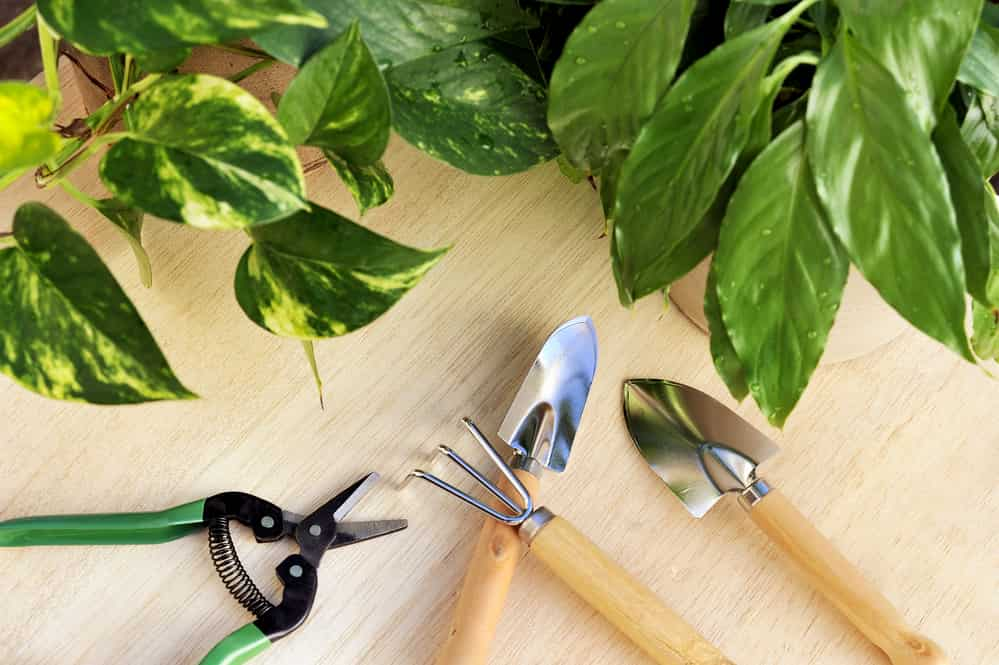
Should you remove yellow leaves from pothos?
Removing yellow leaves from your pothos plant is a great way to encourage new growth. Start by gently removing the yellow leaves from the plant, being careful not to damage the remaining leaves or stems. Use clean, sharp shears or scissors and cut the leaf off at the base of the stem.
As a rule of thumb, you should never remove more than one-third of the leaves from a plant at a time. If you remove too many leaves, it will put stress on the plant and could cause new growth to slow down or stop altogether.
So if your leaves are mostly yellow, pruning them all off isn’t the best idea. Prune about a quarter of the leaves that are in the worst shape and use a few of the methods above to help recover the plant’s health.
Find out more: 6 Simple Steps to Prune Your Pothos
Can yellow pothos leaves turn green again?
In general, a pothos leaf will not regain its bright green color after it has yellowed. This is because the plant is recycling the nutrients in the leaf and focusing on new growth. However, if the yellowing is caused by a lack of nutrients, you may be able to revive the leaf by giving the plant a fertilizer boost.
The best way to keep a pothos green is by catching the yellowing in its tracks and correcting the issue before it gets worse. By following the tips above, you should be able to keep your pothos plant healthy and green for years to come.
Why does my pothos have yellow leaves with brown spots?
A few reasons you may be experiencing this are too much sun, not enough water, or a nutrient deficiency. These factors all stress the plant and can cause the leaves to turn yellow and brown rapidly. They can be corrected by giving the plant more water, moving it to a shadier spot, or fertilizing it.
When the brown spots are on new growth, it is most likely due to too much direct sunlight. The sun scorches the leaves and causes them to turn brown.
A microbial soil-borne disease could also be the culprit. This is more common in potted plants because the same soil is reused and can build up harmful bacteria over time. The best way to prevent this is to repot your pothos plant every year or two and to sterilize your potting tools before each use.
Related: 11 Reasons For Brown Spots on Pothos (and How to Fix It)
Why are my pothos leaves turning yellow after repotting?
One of the main reasons for pothos leaves turning yellow is transplant shock. This happens when the roots are disturbed during repotting and can’t take up water and nutrients as efficiently. The leaves will turn yellow and eventually brown as the plant struggles to recover.
To avoid transplant shock, be sure to repot in the growing seasons (spring or summer) and to water the plant well before and after repotting. You can also add a root stimulator or fertilizer to the potting mix to help encourage new root growth.
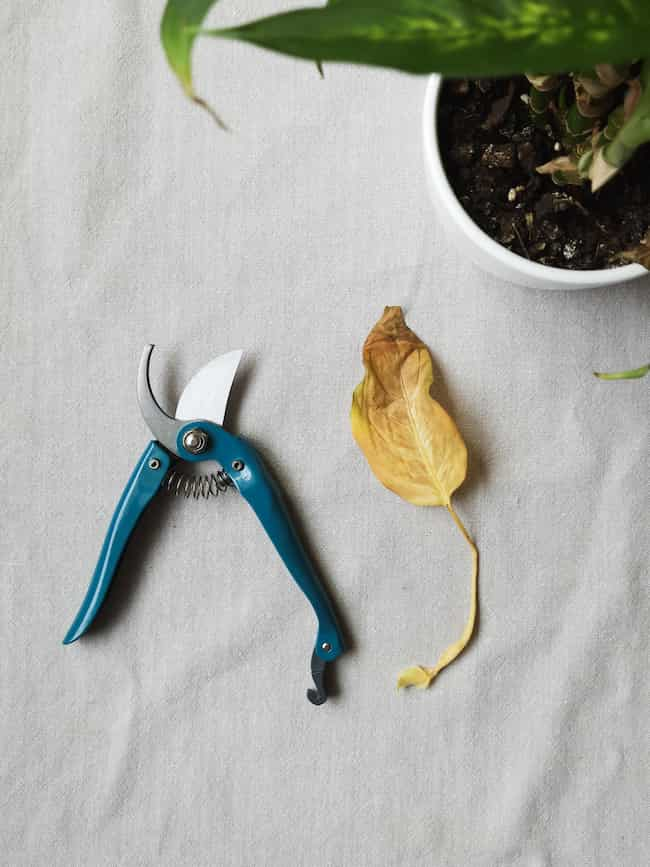
Make sure to give your plant the ideal conditions when repotting it so that it doesn’t go into shock. If it’s unhealthy before you move it to another container, this is an indication that it won’t do well with being disturbed. Try to wait until it’s looking its best before you replant.
How long are plants in shock after repotting?
The length of time a plant is in shock after repotting depends on the plant, the size of the pot, and how well you take care of it. A small plant in a large pot may only be in shock for a few days while a larger plant in a smaller pot could be in shock for weeks.
This is why you may actually notice your pothos leaves turning yellow not only immediately after a transplant.
You can help your plant recover from transplant shock by giving it water, keeping it at the right temperature, and providing it with indirect sunlight on a daily basis. These simple steps should insure a healthy recovery.
Why is there one yellow leaf on my pothos?
A single yellow leaf on a pothos plant is usually nothing to worry about. It could be caused by a nutrient deficiency, too much sun, or too little water. If the rest of the plant looks healthy, then you can just remove the yellow leaf and wait for new growth.
If you see multiple yellow leaves on your pothos, then it’s a good idea to dig a little deeper into the cause. Otherwise, this is a healthy plant with one yellow leaf which is likely simply a natural part of the plant’s life cycle.
How do I know if my pothos is healthy?
A healthy pothos has bright green leaves that are firm, perky, waxy, and free of brown spots or yellowing. The stems should be green and slightly woody. The plant will likely be filled out with a good amount of new growth and will be growing upright.
Some ways to keep your pothos healthy (including to minimize the chances of yellow leaves on your pothos appearing) are to give it the right amount of water, sunlight, and fertilizer. You should also repot it every year or two to refresh the potting mix and help prevent diseases. Regularly pruning the plant will also help keep it healthy and looking its best.
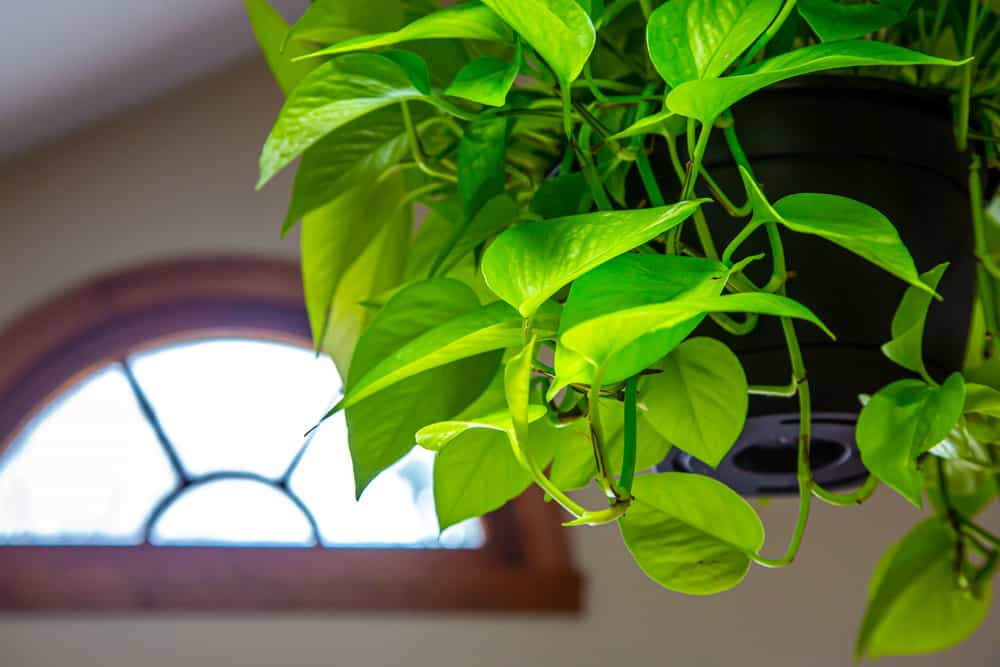
What does an overwatered pothos look like?
An overwatered pothos will have wilted, yellow or brown leaves. The stems may be soft and mushy. You may also see mold or mildew on the plant. If you think your plant is overwatered, stop watering it and let the soil dry out completely before giving it a drink again.
You may have to wait a few weeks before the soil dries out and the plant recovers. In the meantime, make sure to keep it in a well-ventilated space and away from direct sunlight.
How do you encourage pothos to grow their leaves?
Pothos leaves will naturally grow when the plant is given the right conditions. However, regularly fertilizing and pruning the plant will stimulate new growth and create a bushy and full appearance.
To fertilize, use a half-strength fertilizer every two weeks during the growing season, and prune the plant lightly once every month or two.
Related: How Fast Does Pothos Grow (and How to Make it Grow Faster)?
How long can a pothos live?
Pothos plants can live for up to 10 years with proper care. They are relatively easy to care for and can tolerate a wide range of conditions. Their lifespan is shorter indoors than outdoors, but with the right care, they can last a full decade. You can also continue propagating them to create new plants that last just as long.
Is it easy to take care of a pothos plant?
Pothos plants are relatively easy to take care of. They can tolerate a wide range of conditions and prefer to be on the drier side, so they do well if you miss the occasional watering or place them in a darker area of your home.
But like all plants, they are living things, so they can’t tolerate being neglected. If you want your pothos to thrive, then you need to give it the care it needs. This includes regular watering, fertilizing, and pruning.
Where should I put my pothos to avoid yellow leaves?
Many rooms work well for a pothos plant. They are most commonly placed in living rooms or kitchens but can do well in any room that gets indirect sunlight. They can even tolerate low light conditions, making them ideal for offices, bathrooms, or other rooms that don’t get a lot of natural light.
Just make sure there is at least a little bit of natural light, or use a plant grow light to give them the light they need.
